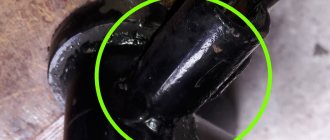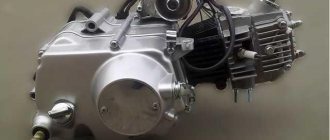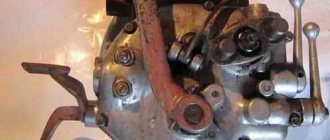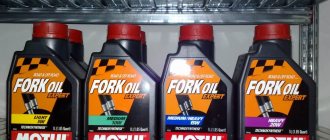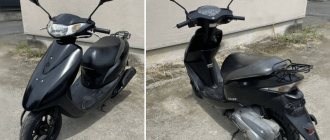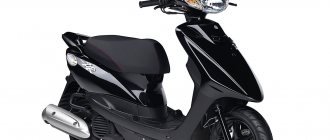Hi all!
Today we will tell you about a vehicle that you will definitely like. Do you think this doesn't happen? And it exists. Meet the Honda dio af68. This is a technique that will appeal to everyone who loves mobile and comfortable driving on the road. For those who prefer two-wheeled vehicles - after all, they have many advantages compared to conventional cars. Let's take a quick look at the scooter from Honda.
Disassembling the Honda Dio AF fork shock absorber
Understanding is not difficult. First, the fork shock absorbers need to be removed; to do this, you need to unscrew 2 bolts from the yoke, on each stay, and pull the shock absorber out of the yoke.
The shock absorber is made up of a glass (10), two bushings: the top (through (5)) and the bottom (blind (8)) made of fluoroplastic (coprolon), a rubber bumper (9), a retaining ring (4), anther (3) , a plug (1), 2 springs (6), a spring stopper welded onto the feather (7) and the feather itself (2). To disassemble the removed shock absorber, you need to pull out the boot and retaining ring, and if there are no problems with the first, then you may need to rummage around with the other. There are 2 lugs at the ends of the locking ring; you need to insert two awls into them, squeeze and then remove the ring.
After this, the feather should quietly crawl out of the glass, but it happens that the upper sleeve sticks to the glass and does not allow the feather to be pulled out. All methods are good here - WD-40 and a little warming up. You may have to crush it and pull it out in pieces.
A little about the Dio crankshaft
I moved away from the “New Year” and decided to write a little about the choice of crankshaft on the Honda Dio 34/35/ZX.
I went online to order spare parts, sat down and sat... But the thing is that for the same money you can buy both a completely good crankshaft and a half-corpse that can crumble at the most inopportune moment. Therefore, you need to approach your choice wisely...
In the previous article, I already mentioned the difference in the width of the crankshaft cheeks GBL(A) and GBLK.
The picture shows the crankshaft for the GBL(A) engine. The first obvious difference is the presence of spacers (washers) between the connecting rod and the cheeks, which reduce the lateral load on the connecting rod (this is a factory option). Under the influence of friction between metals that are similar to each other (the one without washers, on the right), strong thermal expansion occurs, which leads to increased wear of the connecting rod and its “sticking”. Then this wear leads to the connecting rod beating and the whole thing fails, reducing the overall engine life. The second difference is the presence of a certain “depression” in the place indicated by the arrow. In a good crankshaft there is no depression, the shaft is straight.
The third difference is the connecting rod itself. A good crankshaft usually has a central groove (technological hole), this is done to allow lubrication of the separator and to remove excess heat during friction of the separator (and there the load is very good). On a good crankshaft, there are more places for oil seals to fit (indicated by brackets), which reduces the risk of oil seal leaks. Another difference is the thickness of the shaft at the seat of the variator, it is actually not ideal 14 mm, but barely less, this is an allowance for thermal expansion, because unlike bearings (which will rotate in lubricant), here the variator bushing rotates “dry” "
On good crankshafts, places 1 and 2 are usually hot, because these are areas with increased load (although now even famous manufacturers no longer do such things for the sake of saving time). But the place under the number 3 - on a good crankshaft usually contains an abbreviation from the name of the manufacturer or indicates the type of crankshaft (for example, if it is reinforced), while on bad ones there are either no designations at all, or the casting is made of poor quality (fuzzy edges, barely protruding symbols, etc.).
The thread quality of a good crankshaft is much higher; there are no “burrs” or rough edges, which means that when we install an oil pump in the engine, we will be confident in its normal functioning. In addition, all the places that have notches or threads, and the key on a good crankshaft are usually hardened, and of course the quality of the metal itself from which they are made. At famous factories that have large production capacities, as a rule, quality control of finished products is higher, and the crankshafts are calibrated on a robotic machine.
And in order for the crankshaft to run longer, you need to put it on good bearings (the original Japanese NTNs differ in everything from their Chinese copies):
- The original box is made of thick cardboard, with fine corrugation inside and a protective hologram, has rich colors, and the paint cannot be wiped off with a finger. There is a sticker on the bottom of the box (the non-original has an inscription on the box itself, not on the sticker) with the serial number of the bearing that is in it.
- In the original, the bearing has a rather deep engraving (not like a laser, but like a stamp); there is also engraving on the inner race.
- In the original, the crown (I honestly have no idea what the circle that holds the balls inside is called) is a little matte (the fake has a shine), and the rivets are spherical, like a mushroom cap (in the fake they are flat).
- In the original, the outer frame on the inside has a rounded edge, but in the fake it is the same as on the outside.
- The original has no play (with a fake you will immediately feel how the inner race wobbles even on a new one)
- The original must have a generous amount of lubricant (at least on one side).
In general, do not buy bad crankshafts and bearings, their service life is obviously lower, and changing this is another task...
P.s. It makes sense to install sports “full-cheek” crankshafts when tuning an engine together with a changed volume of the CPG, intake, fuel system, etc. If you leave the CPG with its original volume, but install a sports crankshaft, which will reduce the volume of the chambers in the crankcases (calculated at the factory), then your moped may run even worse than with the stock crankshaft, so before you “experiment”, decide whether you are doing repairs scooter or improvement of its mechanics for some specific purposes, since the improvement of one element constantly leads to the improvement of another...
Tags
- Honda
- Dio
- Cesta
- AF34
- AF35
- crankshaft
- NTN
Honda Dio AF fork repair
After disassembly, all that remains is to assess the degree of wear of the elements (replace if necessary), clean the shock absorber from dirt, fill it with grease and reassemble it in return order.
To repair a Honda Dio fork, you may need fresh boots, plugs and bushings, as well as other parts.
The bushings can be turned by a turner. Material: coprolon, as a more wear-resistant material.
After repair, the fork will become simply unrecognizable and is in no way inferior in softness to the Honda Tact. The result of the repair will gradually begin to be lost after 3.5 thousand. km driven on our roads.
Dirt is a terrible enemy of these (and not only) shock absorbers; pay attention to the condition of the dust plugs and boots.
Updated Dio 34 chassis
In principle, at the time of purchasing the Dio 34, I was already clearly aware of the need for capital or a complete replacement of the chassis. The question arose: “What to choose?” The fact is that restoring, although original, “dry” fork stays with Chinese repair kits, then also fiddling around with polishing the stays and painting in order to end up with the same “dry” fork in the realities of our road conditions is such an undertaking. You could, of course, look for a hydraulic one, like on the Dio ZX, but then you would have to change the entire brake system to hydraulic, and this (taking into account the cost of the fork itself) is in no way justified on this scooter.
Apparently the original rear shock absorber could not cope with the load and was previously replaced by the previous owner with a 340 with spring preload from a 2-seater scooter. Unfortunately, storage under the fence or operation in “submarine” mode killed it too. Therefore, I decided to purchase parts in the mid-price segment. I searched for a long time, the choice was between famous Indian and Taiwanese manufacturers, I settled on the latter, because... I was given a big price for them. guarantee.
The rims and tires arrived separately. The stampings are heavy, the metal is good, but the painting is so-so, the layer is a bit thin. If I have some free time, I’ll restore the original ones, but for now there will be these. The scooter had tube tires installed, which were already pretty worn out. I decided to install tubeless. Front 4c for 125 kg load of medium profile, rear 6c for 175 kg - more “toothy”, but everything in moderation. I need such tires because... I’m going to go fishing, and the roads around the city don’t look like a Formula 1 track. The rolling resistance on these tires is moderate and will not affect consumption much.
The front and rear brakes on the Dio 34 are drum brakes, the pads are interchangeable, the size is standardized with many foreign-made scooters and mopeds. I installed pads with grooves in the friction linings. Both brake cables were jammed, the rear one was restored, and the front one was replaced.
Dio is a very low scooter and touches everything it can with its belly. After assembly, I made a comparative measurement with the same load on the shock absorbers (I did the first one before I disassembled the scooter down to the frame). The fork legs without load are 3.5 cm longer, the rear shock absorber is 340, the same as the one that was at the time of purchase. Initially, the clearance to the ground in the area of the central leg was about 11 cm, now it is about 13 cm. It seems like a small thing, but still. Let's see how the suspension settles after complete assembly and my weight...
Well, for the money:
- Hydraulic fork stays – $20
- Rear shock absorber - $10
- Rims, front bearings + nipples - $34
- Tubeless tires – $31
- Brake pads + front brake cable – $7
Total: $102
P.S. the scooter begins to take on at least some shape. I hope to be able to fully assemble it before the start of next season. Health and goodness to everyone!
Tags
- Honda
- Dio
- AF34
- AF35
- Cesta
- chassis
Dimensions of coprolon (fluoroplastic) bushings for Honda Dio AF-25
| Parameter | Size (mm) |
| Inner diameter of glass | 35,4 |
| Upper bushing outer diameter | 35,3 |
| Upper bushing inner diameter | 27,5 |
| Top bushing height | 30 |
| Bottom bushing outer diameter | 34,8 |
| Bottom Bushing Inner Diameter | 27,2 |
| Bottom bushing height | 30 |
| Thickness of the bottom of the lower bushing | 5 |
| Holes in the lower bushing | 2,5 — 3,2 |
Briefly about the important
This scooter model was produced for four years - from 2008 to 2012.
It immediately gained popularity because it combined excellent technical characteristics, durability, ease of use and was sold at a reasonable price. It is especially compact and highly maneuverable. It has high reliability qualities and great potential for tuning. For these reasons, the model has become wildly popular. Such a scooter can be seen en masse on the roads of Japan, the Russian Federation, Germany and Ukraine.
The Japanese manufacturer produces this model in two trim levels - this is the traditional Dio version, which has a drum front brake, and the Dio Cesta, which has a convenient front basket.
The most remarkable thing is that the gasoline tank was removed from the underground part and installed in the underseat area.
Ordinary scooter users highlight one main feature in it - it is economical. It consumes extremely little fuel.
If you drive at a speed of 30 km/h, then you will spend about 1.25 liters per 100 kilometers.
These are just ridiculous numbers, which certainly makes drivers happy. Naturally, the maximum speed of the scooter is much higher and is 60 km/h. This speed is considered traditional for this line and is quite sufficient.
Dimensions of oil seals and bearings for Honda dio scooters Honda dio
Many people are confused about which oil seals and bearings to order for their Honda engines. Well, let's figure it out together!
You will find the model and number of your Honda scooter engine on the front of the gearbox cover, right above the filler bolt.
1) AF-18E engine (stamped on the gearbox cover) with a “thin” 12mm crankshaft (Dio 18 and the same with a disc brake Dio 25; Dio 27 and 28 of the first releases, then they made a thick 14mm shaft on them)
You will recognize this motor by its characteristic counter jaw, 14mm variator nut and the thread itself on the shaft is 10mm, pitch 1.25:
The crankshaft bearings are the same on both halves of the crankcase, you need 2 pieces
D=52mm d=20mm h=12mm, you can buy here diomarket.ru
The oil seals are the same on both halves of the crankcase, you need 2 pieces: D=25.5mm d=15.5mm h=7mm you can buy here: diomarket.ru
2) AF-18E engine model with a “thick” crankshaft (wide belt) (almost all 27e, 28e) AF-24E engine model with a “thick” crankshaft
(HONDA TACT AF 24, AF 30/31, Giorno 24)
You will recognize this motor by its characteristic counter jaw, 17mm variator nut and the thread itself on the shaft is 12mm, pitch 1.25:
The crankshaft bearings are the same on both halves of the crankcase, you need 2 pieces
D=52mm d=20mm h=12mm, you can buy here diomarket.ru
The oil seals are different on the crankcase halves, you need 2 pieces: D=25.5mm d=15.5mm h=7mm and D=31mm d=20mm h=7mm, you can buy here diomarket.ru
3) AF-34E engine. There are 2 modifications of this engine: GBL and GBLK. Now let's talk about where the manifold has 4 mounting bolts (GBL) (Dio 34-35 SR, Dio Cesta)
Crankshaft bearings will require 2 pieces: D=56mm d=20mm h=12mm buy bearings dio 34 Oil seals, you will need the following: 1) D=25.5mm d=15.5mm h=7mm; 2) D=31mm d=20mm h=7mm diomarket.ru oil seal dio 34
4) engine AF-34E model with engine modification GBLK (intake manifold with 3 bolts)
(Dio 34- 35 SR,Dio Cesta)
Crankshaft bearings will require 2 pieces: D=52mm d=20mm h=12mm can be bought here diomarket.ru Oil seals, you will need the following: 1) D=25.5mm d=15.5mm h=7mm; 2) D=31mm d=20mm h=7mm diomarket.ru oil seal dio 34
BEARINGS AND SEALS IN THE GEARBOX OF HONDA DIO \ HONDA TACT Oil seal on the clutch shaft D=30mm d=17mm h=5mm Oil seal on the front wheel shaft D=40mm d=24mm h=7mm Bearings are standard everywhere. You will need: 6201 - 1 pc. In the crankcase “in depth”; D=32mm d=12mm h=10mm 6202 — 1 pc. In some AF-34E engine models, this bearing may be absent; the wheel shaft rotates in a seat on the gearbox cover; D=35mm d=15mm h=11mm 6203 — 1 pc. In the gearbox cover. D=40mm d=17mm h=12mm 6203 2RS — 1 pc. (closed separator with gland seal) D=40mm d=17mm h=12mm
5) AF05E (Pal, DJ-1, Tact 16)
The crankshaft bearings are different, you will need 2 pieces: 1)D=47mm d=20mm h=12mm (SC04A31
marking) 2) D=40mm d=17mm h=12mm
Seals are the same, 2 pcs. , you will need the following:
D=25.5mm d=15.5mm h=7mm
Source: https://honda-dio.clan.su/forum/4-43-1
What according to the characteristics
The technical characteristics of the scooter are quite decent. The engine capacity is 49.9 cubic meters, that is, almost 50 cubic meters, which is quite good for a scooter. A four-stroke engine is installed inside, which lasts for many years and does not break down. It is air-cooled and meets the environmental requirements that apply to all vehicles. This means it is safe for the environment, which is a big plus.
The AF68 starts using electric start and kickstarter. The type of front and rear brake is drum type. The seat height is almost 70 cm, which allows you to feel comfortable while riding.
The number of seats in the Honda dio af68 traditionally stops at two. You can sit comfortably in the front seat to drive the scooter, and put your girlfriend in the back and fly down the road together. Agree, this is wonderful, isn’t it? Moreover, there is a convenient trunk under the seat, which allows you to put all the necessary and important things in it. For example, documents, a bag or a business briefcase.



